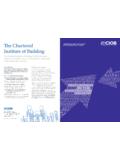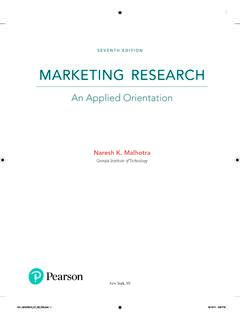Transcription of The Chartered Institute of Building The impact of - CIOB
1 The impact of the ageing populationon the construction industryThe Chartered Institute of BuildingThe Chartered Institute of Building (CIOB) represents for the public benefit the most diverse set of professionals in the construction of contentsExecutive summary 3 Introduction 4 Background information 4 What is an ageing population? 4 Why do we have an ageing population? 4 What are the challenges? 4 impact on the construction industry 5 Methodology 5 The sample 5 Results 6 Discussion 20 The impact of the ageing population on the construction industry 20 The challenges 20 Adapting the built environment 21 The construction workforce 22 Recommendations 232323 Executive summaryFor the first time in Britain, there are more people of a pensionable age than children under sixteen1.
2 A changing demographic that the Government describes in its Lifetime Homes, Lifetime Neighbourhood Strategy as the biggest challenge of the 21st century. Approached from the perspective of senior level construction workers, this research examines how the ageing population will impact the industry and reveals a serious challenge. The state of the existing Building stock needs sober consideration, as many homes and buildings are unsuitable for and inaccessible to older people. In addition, new buildings need to be designed to accommodate all age groups, including the older members of society.
3 However, the ageing population doesn t only affect Building design and structure; it s also having a serious impact on the construction workforce and the industry itself. The survey exposes two important trends in terms of labour-force numbers within certain age groups:1) In the construction industry, the total of workers over 60 has increased more than any other age ) the biggest reduction is in the total of workers under likely impact is as clear as it is worrying: a great deal of knowledge and many vital skills are about to be lost and fewer professionals are in line to replace either.
4 This survey also shows that the majority of respondents (76%) are aware of the challenges facing the construction industry, but less than one quarter (24%) are aware of these issues being taken into consideration on projects. While the Government appears to have recognised the urgency of this matter and considered it at some length, 60% of respondents feel that the political leaders of the United Kingdom (UK) aren t doing enough to deal with this challenge. Despite this view, a sense of urgency has not filtered down to the construction industry even though making important changes now could greatly improve the environment for the elderly.
5 More needs to be done to raise awareness across the professions, and to assess the importance of developing standards that help improve public and commercial buildings. 1 Office of National Statistics45 Introduction Background informationThe Chartered Institute of Building (CIOB) is the leading professional body for managers in the global construction industry. Established in 1834, the CIOB continues to lead the way in establishing, promoting and maintaining standards of excellence in the sector.
6 The CIOB draws its members from a wide range of professional disciplines, from across the Building and construction supply chains. These include clients, consultants and contractors, as well as specialists in regulation, research and education. The purpose of this research is to investigate the effect of the ageing population upon the construction industry. Through the perception of construction professionals, it examines the industry s awareness of the issue and its response to it, in terms of the best way to approach the challenge.
7 This research will attempt to raise awareness of the issue in general, as well as promote best practice and age awareness within the construction industry itself. What is an ageing population?An ageing population means that there s a higher number of people living for longer than there are people giving birth. This has led to today s unique situation in the UK: there are now more people of a pensionable age than children under sixteen. A recent study shows that the 100+ age group is the fastest growing in many developed countries.
8 In the United States, the number of people over 100 is expected to quadruple by 2030. The number of British centenarians is currently rising at 5% a year2, while those over 80 comprise the fastest growing age group in the United Kingdom. Why do we have an ageing population?Several factors have contributed to the increase in the number of people of a pensionable age. One of the main reasons is the improvement in mortality at older ages. Health care and health awareness both continue to improve, with new breakthroughs and knowledge that allow people to live longer and remain healthy.
9 There have been improvements in housing and living standards too. It s become increasingly possible for the elderly to heat their homes (because of increased energy efficiency) and to continue living independently for longer thanks to the improved layout of houses. Another contributory factor relates to the number of babies born after World War Two, in the baby boom period. These people are now reaching retirement age, causing a great surge in the numbers. What are the challenges?This change in the demographics of the population leads to a number of challenges, affecting many aspects of society.
10 One of the biggest issues is the strain on the decline in the ratio of workers to pensioners will cause a great burden on those who are still working. There are currently people of working age to each person above state pension age, but this figure is expected to drop to in 20323. One way to meet this challenge would be to extend the retirement age and keep more people in work. This is already being done, by equalising the retirement age of men and women at 65. There is also a plan to increase the state pension age to 68 by 20504.













